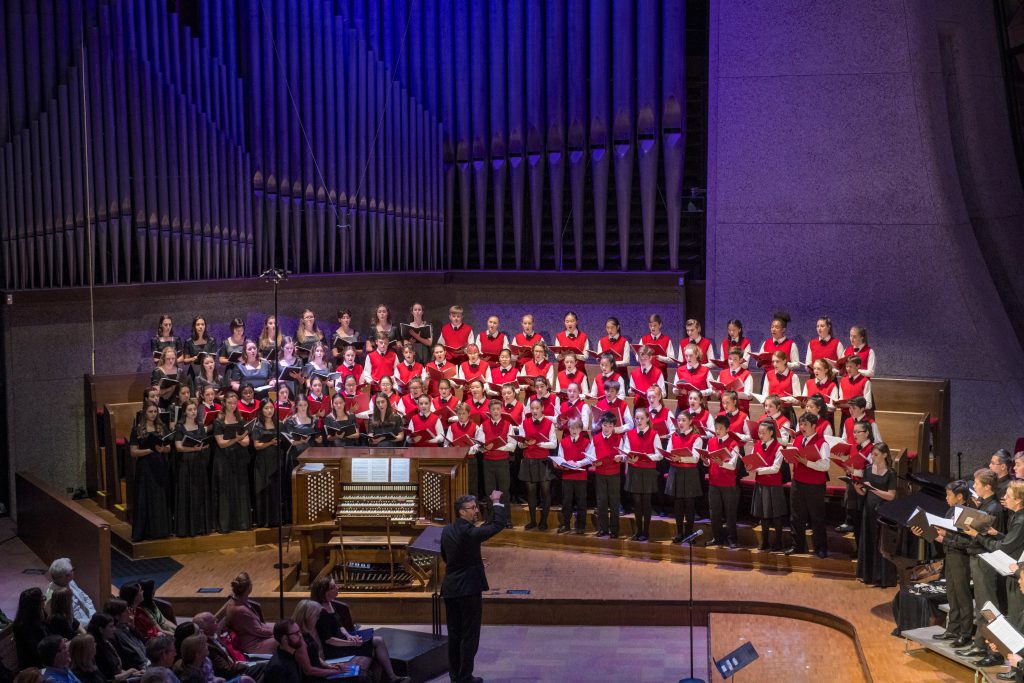On two consecutive Sundays, December 9 and 16, at 7:30 p.m., the Los Angeles Children’s Chorus (LACC) will present what promises to be a bang-up program at the Pasadena Presbyterian Church.
“Winter Wonderland: Sounds of the Season” marks the first stand-alone program led by the Chorus’ new artistic director, internationally regarded choral conductor, clinician, and educator Fernando Malvar-Ruiz.
The entire chorus comprises 400 kids and seven choirs. Two hundred and fifty of them will perform in December’s programs.
Associate Artistic Director Mandy Brigham leads the Intermediate Choir, Diana Landis leads the Apprentice Choir, and Dr. Steven Kronauer conducts the Young Men’s Ensemble.
Malvar-Ruiz will conduct the Concert Choir, the Chamber Singers, and the new SATB Choir (soprano, alto, tenor, bass), the mixed-voice ensemble he established in August.
“They’re all quite different. The Concert Choir is a treble choir, which means high voices. It’s a mixed ensemble, meaning young boys and girls, and they all sing both soprano and alto.”
“The Chamber Singers are young women between 16 and 18. It’s a more mature sound. The SATB Choir is both young men and women singing a repertoire that has moved beyond the younger high voices.”
The program includes carols and folk songs from around the world, seasonal songs from Venezuela — where Malvar-Ruiz spent his youth — and winter-themed works by classical composers from various countries and eras.
Though the concerts are different, each will have five sections, each based on a different holiday theme and introduced by a single a cappella voice.
Among the works featured are Elgar’s “The Snow,” Kodály’s “Stabat Mater” for male voices, the gorgeous Bach cantata “Sleepers Awake,” and Verdi’s “Laudi Alla Vergine Maria” (“In Praise of the Virgin Mary”), based on a poem from Dante’s “Paradiso.”
How do the kids come to participate in the chorus?
“Each spring, the call goes out to the community. If the audition is successful, and the large majority are, then we place the child in whichever choir will benefit him or her most. They’ll stay there until they’re ready for the next level.”
“The system works really well. We lose very few children from year to year. The chorus is Pasadena-based, but the offering is so unique we have children from all over LA.”

What draws Malvar-Ruiz to young singers, with whom he’s worked his whole professional life, as opposed to adults?
“One, children are artistically honest. If they like something they love it. And if they don’t, you don’t have to guess. Also, unlike adults, children have been told very few times, ‘You will never be able to do this.’ Young artists are capable of amazing things and an incredible level of sophistication simply because they believe in themselves.”
“Two, there is nothing like the sound of a good children’s choir. The purity, a certain level of innocence, and the honesty combine to create a sound that goes straight to your heart.”
As artistic director of American Boychoir for 18 years, he’s now something of an expert on the adolescent male evolving voice.
“The attitude toward voice change has changed dramatically in the last few decades, fortunately. It used to be that the boys would be told to stop singing until the change was over. In many cases, however, they stopped singing forever,” he said.
“So now they’re given pieces to sing while the voice is in the process of changing. We teach them to learn to trust the notes they have, and to sing those. The range is narrower and the voice for a time is often quite unstable. So they may be able to sing only 25 percent of a given piece, but they sing it.
“The real work with this particular kind of singer is psychological. You have to let the boy know that at the end of the transition, he’s going to have a voice that’s just as beautiful in its way as the treble.”
When an LACC boy’s voice begins to change, he’s placed in the Young Men’s Ensemble, which will perform December 9.
“Dr. Kronauer helps them to develop. Those whose voices have already changed combine with the voices of boys who are still going through the process, and together they create a beautiful, beautiful sound.”
Malvar-Ruiz created the SATB choir to bring the process full circle.
“The boy starts out singing soprano with girls who are also singing soprano. When his voice changes, he goes to the Young Men’s Ensemble. When he’s ready for the SATB choir he goes back to singing with the girls he was singing with when he was a treble. The kids love this. If you sing with someone, it’s impossible not to form a bond.”
We know the feeling from church when we sing hymns with the people around us.
“It doesn’t need to be Bach or Mozart. We feel connected in some mysterious way when the focus is something that’s bigger than we are,” he said.
“It’s a very human activity. There’s no culture, present or past, that has not an element of common, group singing of some sort. It cannot be overestimated how wonderful it is to raise our voices in song with others. That’s what choirs capture.”
Heather King is a blogger, speaker and the author of several books. For more, visit heather-king.com.
SPECIAL OFFER! 44 issues of Angelus for just $9.95! Get the finest in Catholic journalism with first-rate analysis of the events and trends shaping the Church and the world, plus the practical advice from the world’s best spiritual writers on prayer and Catholic living, along with great features about Catholic life in Los Angeles. Subscribe now!

